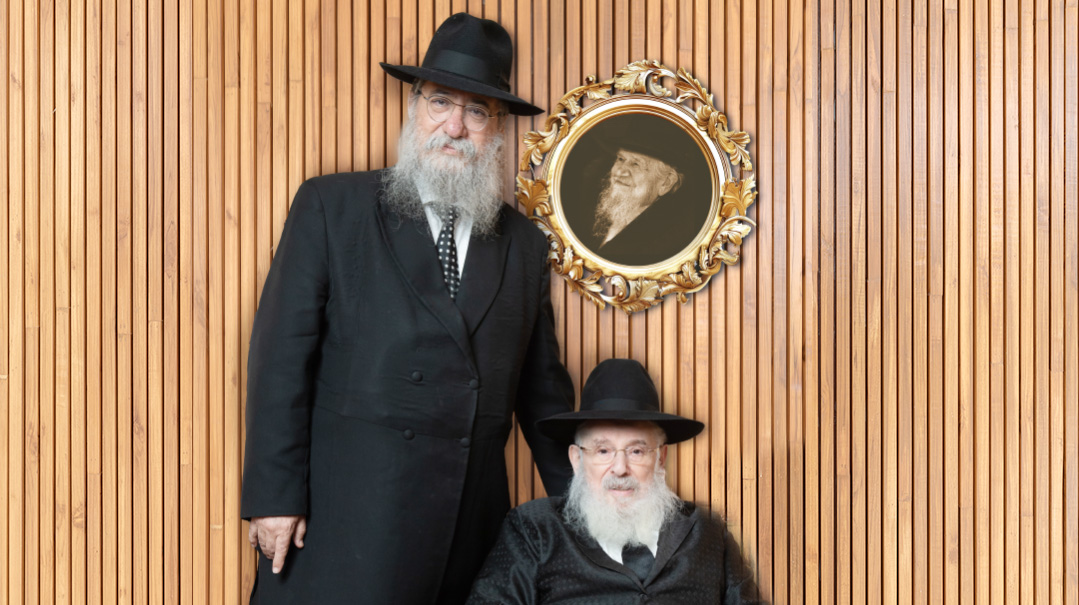Eyes to the Mountain

The Vayimaen movement taps our innate ability to say no

Photos: Vayimaen.org
The quintessential battle cry of a Jew overcoming his yetzer hara is Yosef Hatzaddik’s decisive “Vayima’en” — endowing Klal Yisrael with the power and fortitude to overcome their struggles for all generations. Today, the Vayimaen movement’s daily three-minute videos have transformed the lives of so many, revealing every Jew’s holy spark and the faith Hashem has in every one of us to withstand the temptations He alone put into the world
We’ve learned the hard way that symbols of strength can be anything but. We took pride in those two towering structures defining New York City’s skyline; today, the gaping void is a constant reminder of our vulnerability. The most powerful governments have crumbled, the wealthiest corporations have gone bankrupt.
Strength, we’ve come to learn, is untrustworthy.
Why is that?
“Eizehu gibor?” asks the mishnah in Pirkei Avos. “Hakovesh es yitzro — he who overcomes his yetzer hara.” The Maharal explains that all other forms of strength are determined by societal perception. Transient realities aren’t necessarily real, and the strength we once believed in was actually never strong in the first place. The kovesh es yitzro, however, is absolute. It is the one true strength that no one can take away.
Yosef Hatzaddik is the very paradigm of a kovesh es yitzro. The encounter with Eishes Potiphar was set to all but consume him, and then… in one decisive moment of strength — “Vayima’en!” — Yosef triumphs, endowing Klal Yisrael for all generations with the power and fortitude to win their battles.
Thousands of years later, that strength continues to reverberate — the clarion call of “Vayima’en!” growing with every passing day — quite literally.
Less than one year ago, a movement called Vayimaen came into being. Today, over 35,000 people have subscribed to the daily three-minute videos that have transformed the lives of so many.
It’s a level of success whose secret lies in that single mishnah: Eizehu gibor — hakovesh es yitzro.
Tapping into the reservoir of defiant energy that comes as every Jew’s birthright, Vayimaen reveals to everyone their one and only true strength.
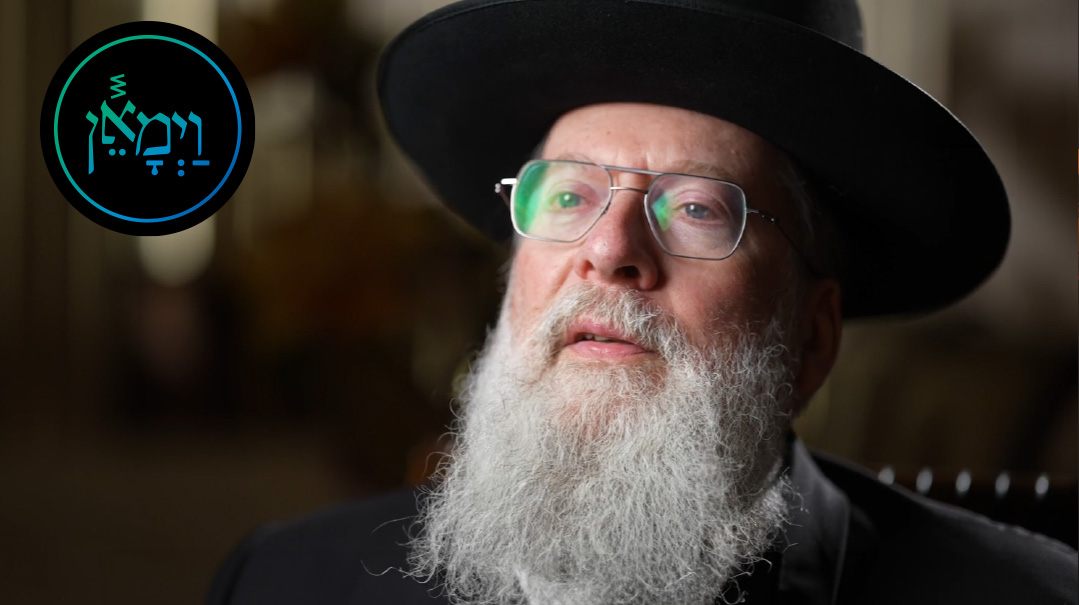
Rabbi Moshe Tuvia Lieff, one of Vayimaen’s popular presenters, shares a positive affirmation as he advocates for every Yid’s innate strength: “I’m a ben melech, and it’s beneath my dignity to let my eyes wander”
T
he behemoth global initiative has a genesis that’s hard to pinpoint. No one person will claim ownership, or even credit, for Vayimaen, as all those involved recognize that something far greater than the sum of them is pulling the invisible strings.
Moshe Grunhut would introduce himself as a typical working guy in Flatbush.
“I just had a moment of clarity one day,” Moshe says. “When it came to my shemiras einayim, I always kept my eyes pretty much in line, but I realized I could hold myself to a higher standard. So much of what we see in our regular lives becomes normal to us, but I realized that I had an opportunity to shake up the status quo.”
Moshe decided to take upon himself to be more serious about where he’d go and who he’d meet, and adjusted much of his daily routine in order to live with a heightened level of adherence.
“I did this for two weeks,” he says. “I was careful with every one of my interactions. And what can I say? It completely changed me. It felt like my neshamah had resurfaced after just a short while. Everything about my spiritual life improved. It’s still something I constantly work on, but those intensive two weeks changed everything.”
Realizing the life-altering transformation he had experienced, Moshe looked upward. “I remember saying to Hashem, ‘When I have the time and resources, I want to help others do what I did. I want them to find the gift I found of shemiras einayim.’ ”
That comment was left hanging; there was no knowing if and when the dream would ever materialize.
Meanwhile, down the Garden State Parkway, Lakewood-based Yitzy Cziment was contending with the fresh sense of loss for his beloved grandfather, Rabbi Avi Shulman a”h.
“My grandfather had passed away, and I felt I needed to do something,” Yitzy explains, “but I wasn’t sure what that thing should be.”
Rabbi Shulman was a legendary mechanech who had dedicated much of his 89 years to teaching students and mentoring educators. His legacy was one of macro influence, and Yitzy knew that the appropriate commemoration would have to take on that character as well.
And so, he put in a call to the Chofetz Chaim Heritage Foundation.
“I left a message, asking for a meeting. I wasn’t even sure what I was looking for. But pretty soon an appointment was arranged.”
The conversation with Chofetz Chaim Heritage Foundation turned out to be far more productive than he could have imagined. Together, they worked on identifying pertinent spiritual challenges whose solutions had not yet been addressed on a community-wide level. They were struck by the following thought: All over, there are issues of shemiras einayim. The average healthy, well-adjusted person, going about his regular day-to-day life, will have to contend with the struggle. Establishing an entity that would address this very human challenge, that would provide regular empowering messages that would help people live better, stronger, more uplifted lives, would be revolutionary.
The meeting was over and the nucleus of an idea began to hatch.
Yitzy reached out to a close friend, businessman, and community askan Reb Chesky Kauftheil, and the plan to spearhead a movement that would take the idea of shemiras einayim head-on was shared with a small select group of friends — one of whom happened to be friends with Moshe Grunhut.
“When I heard that someone was starting a program focused on shemiras einayim, my jaw dropped,” says Moshe. “This is exactly what I had been hoping for!” Moshe approached Yitzy. “I’m in,” he said, “whatever it is that you need me to do, I’m in.”
But yet a third member to the founding board clarifies that it really isn’t a founding board at all. Shaya Wilhelm of Baltimore is Yitzy Cziment’s first cousin — also a grandson of Rabbi Avi Shulman.
“Yitzy and I had worked on several projects together,” Shaya relates. “When he called me about this shemiras einayim idea, I said ‘Yitzy, there’s no way you’re leaving me out of this.’” Shaya was now an active member on the team as well, but clarifies, that “we don’t think of this as an organization. We see it as a movement. Vayimaen is something beyond anything one man can do. It’s the dedication, input, and sacrifice of the thousands of followers that makes it what it is.”
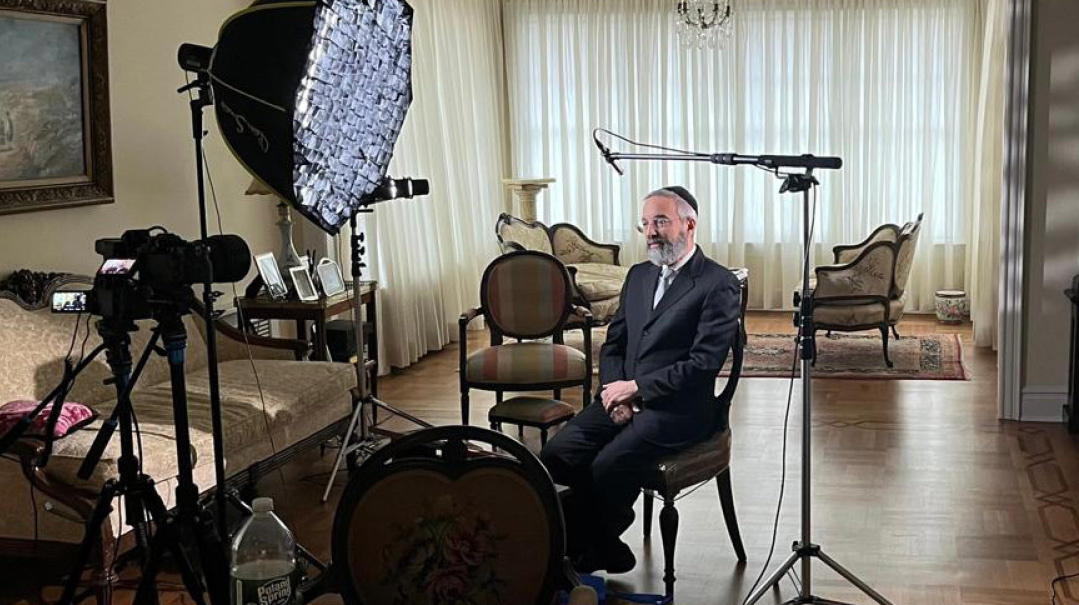
Rabbi David Ozeri says that with a little mental switch, every challenge can be converted into an opportunity
B
ut what, exactly, is Vayimaen? What is its mission? What is its message?
Yitzy and Shaya are very clear in their explanation. “The idea of shemiras einayim, guarding one’s eyes, has generally been presented in a negative context, the focus on the decadence of society and the spiritual harm caused by engaging in it.” But, they explain, Vayimaen isn’t about that at all. “The message of Vayimaen is entirely positive. It’s all about the gift of being able to rise above natural human instinct. It’s about the wealth of spiritual opportunity waiting for us the moment we take that step. It’s about the immensely powerful segulah that the seforim teach us comes along with shemiras einayim. Vayimaen is popular because it is entirely positive.”
And that’s not the only reason. Another central theme to Vayimaen’s mission is not to limit the conversation to technology. Rather, Vayimaen takes a very human perspective, focusing on the day-to-day challenges confronted by anyone and everyone, whether it’s shopping in a grocery store, walking down the street, or navigating through an airport. Vayimaen also challenges the perception that shemiras einayim issues exist only within secular settings. The yetzer hara is everywhere and doesn’t discriminate between frum and not frum. Weddings, bar mitzvahs, or even the shul kiddush are all environments that demand constant awareness with shemiras einayim; the workplace setting, which demands long hours in a confined space, behooves an even greater call to vigilance.
Because Vaymaen’s focus is so regularly applicable to so many of us, it enjoys singular receptiveness. And that, in itself, is part of the mission. A critical feature in making this challenge surmountable is opening it up for conversation. One of the objectives of Vayimaen is to make the topic of shemiras einayim something to be proud of, an accomplishment to tell your friends about.
In terms of execution, the plan was simple: A list of well-known personalities in the wider frum community would be lined up and each would deliver a short idea, no longer than three minutes, which would be shared daily. The content could be anything from a devar Torah to a story to a personal insight or experience.
“We launched the first video on the week of parshas Vayeishev where we read about Yosef Hatzaddik overcoming the ultimate temptation,” says Yitzy. Seventeen-year-old Yosef Hatzaddik, rejected by his brothers and living all alone in a land where promiscuous depravity defined its very culture, was repeatedly approached by the wife of his master, Potiphar. In describing Yosef’s response to her demands, the Torah says, “Vayima’en — And he refused,” together with the triple shalsheles cantillation, which only comes up three other times in Torah.
Potiphar’s wife approached Yosef “yom yom — every day” — quite relatable to our times where the challenges come “yom yom” come with never-failing consistency.
Through a daily dose of positive encouragement, Vayimaen would provide a yom yom of a different sort.
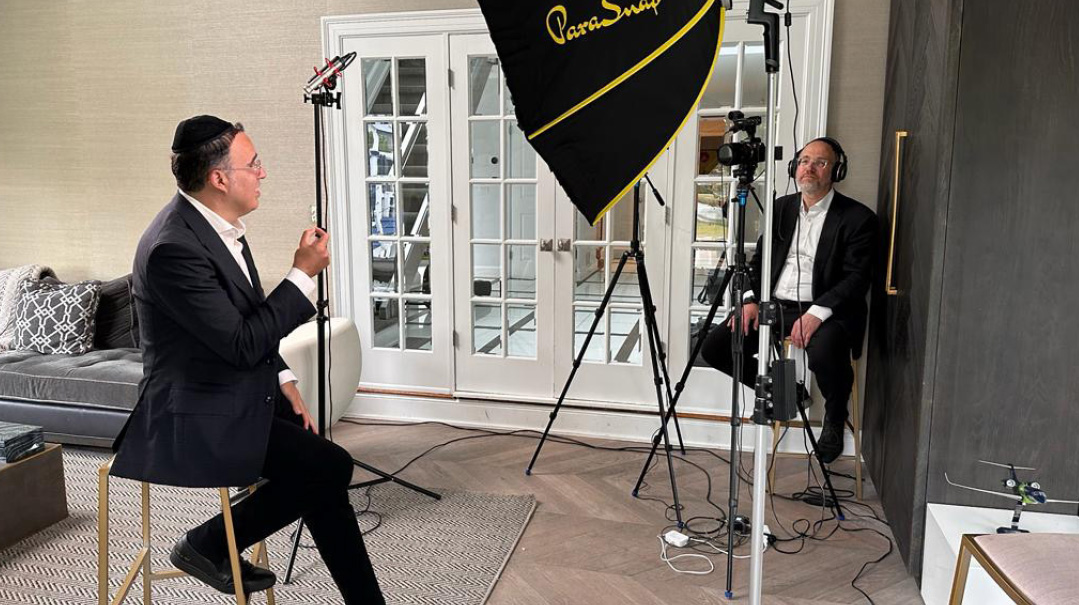
Studio cameras capture Yaakov Shwekey (top) and Rabbi Shlomo Landau. “It’s not just about the miracle stories. It’s about the raw struggles”
IN
addition to the upbeat messages, there are several other elements that contribute to the impact of the Vayimaen clips.
“We have to learn from the success of the opposition,” says Yitzy. “Multinational media is responsible for so much damage and destruction in terms of shemiras einayim, and we knew that to combat it, we’d have to follow their model.”
That meant producing top quality videography, with stimulating sound effects and riveting supplemental footage.
“After the first video was taken, we had just 12 hours until launch date,” says Yitzy. “I got hold of an editor in Eretz Yisrael who gave us a very reasonable quote. Within a few hours he had it back to us and he had done an incredible job.”
That first video featured Rabbi Yaakov Asher Sinclair, who is now a regular contributor to Vayimaen. As time would go on, the list of contributors would expand to include a wide and impressive variety of rabbanim and public speakers.
These videos — close to 200 so far — are distributed via WhatsApp, email, or through the Vayimaen hotline. They are also available on Vayimaen’s website as well as on TorahAnytime. Pinchas Pernikoff is in charge of posting the videos.
“I post each day’s video early in the morning,” says Pinchas. “An hour later, my phone is blowing up with responses.” Sometimes, he says, the comments are as inspirational as the videos themselves.
Pinchas posted a video by Rabbi Ari Bensoussan, who shared the concept of a “Rav Dessler moment.” Reb Ari’s clip was based on a story of how Rav Eliyahu Dessler was separated from his family during the war years. One day, a letter arrived in the mail — it was from his wife! Someone present assumed that Rav Dessler would tear open the envelope in excitement — but he didn’t. Rather, he waited several minutes, and only then did he open the envelope and read its contents.
The observer questioned this conduct. “Why didn’t the Rav open the letter right away?” he asked.
Rav Dessler explained: “All my life, I’ve trained myself to avoid lunging after temptation. I waited a few minutes so that my response shouldn’t be impulsive.”
Not long afterward, Pinchas received the following message from a rebbi in a yeshivah:
“I had made a deal with my talmidim that they hand in their cell phones for a few days. When the time was up, all the boys came to me to retrieve their phones. But one boy held back. When I asked him why, he explained, ‘This is my Rav Dessler moment.’ ”
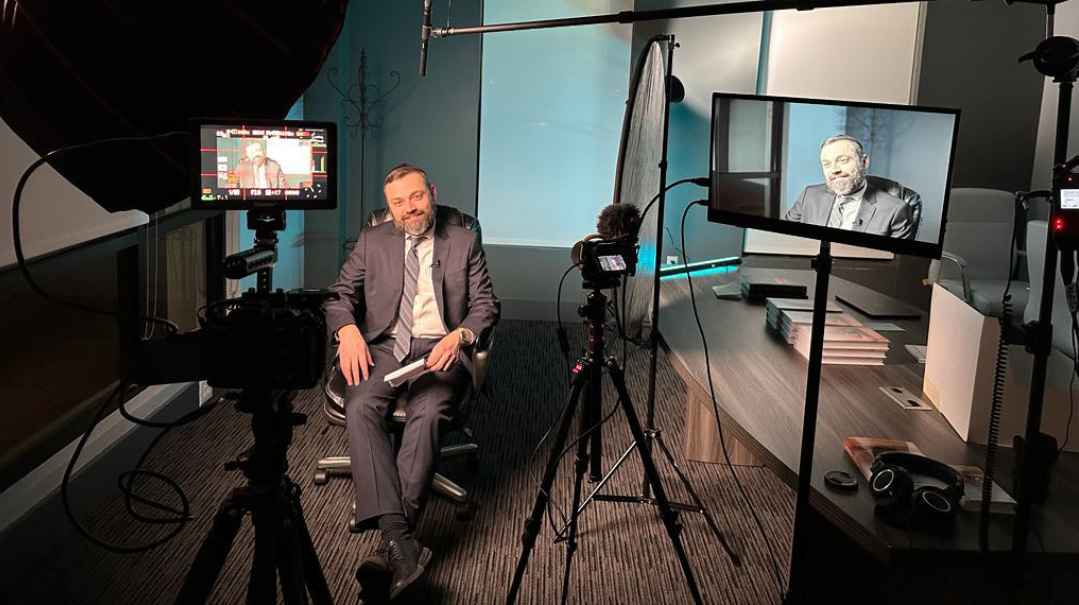
E
ach video begins with the same introductory musical bar as the Vayimaen slogan — the word “Vayima’en” written in Hebrew along with the shalsheles, soon zooming in on the particular speaker. But he won’t be the focus for long. Within moments, the scene shifts and the viewer is carried away in a cloud of state-of-the-art cinematography — it might be to a forest, an ocean, a teeming city street, or the Third Beis Hamikdash.
The content of the videos varies with each speaker’s personal style and message — with some real-life “miracle” stories thrown in for good measure.
In one clip, Rabbi Shlomo Landau of Torah Links/Olami shared that, statistically, there are about 1.2 million passengers flying on planes at any given moment, and one of those passengers will often be a certain Israeli maggid shiur who delivers classes around the globe and as such is a very frequent flyer. But his travel agent knows that his choice of air travel is very specific: He’ll only travel on flights with older planes that don’t have private video screens installed (even if he’d abstain from watching his own screen, the screens surrounding him would be too problematic). If he couldn’t find an old plane, he’d make sure to take a daytime flight so that he would have the energy and awareness to focus on his learning rather than his surroundings.
But it happened once that there were neither old aircraft nor day flights available. And so, the maggid shiur prepared himself, bringing along seforim, a caffeine pill, and even a pair of eyeshades.
He boarded the flight and noted how his seat was in the middle of a set of three. He nodded cordially to his neighbors, and they nodded absently in return; both appeared to be tampering nervously with their screens, which were stubbornly remaining black. They called over a flight attendant who pushed a series of buttons — to no avail.
“I’m terribly sorry,” she said, “every other screen on this plane seems to be working.”
Other videos will share a thought or insight with a very practical takeaway lesson. Rabbi Naftali Horowitz, managing director of Morgan Stanley Wealth Management told of a time when he was in need of a certain yeshuah. A mekubal advised him to light 18 candles in the memory of the Tanna, Rabi Masya ben Charash, and to recite Chapter 86 of Tehillim each time. Rabbi Horowitz was intrigued by the segulah — who was Rabi Masya ben Charash? What about his memory affected such divine favor?
According to a midrash in parshas Vayigash, Rabi Masya ben Charash was exceptional in his shemiras einayim, and so the satan requested that he be allowed the opportunity to try and seduce Rabi Masya to sin.
“Fine,” Hashem responded, “but you will never succeed.”
The satan disguised himself as the most beautiful woman in the world and stood before Rabi Masya ben Charash. He turned his head the other way. The Satan then stood in the direction that he faced and he turned away again. This went on for some time until Rabi Masya began to feel his resolve waning. He called to one of his talmidim to bring him a hot spear, and then Rabi Masya proceeded to poke out his own eyes. At that moment, the satan dissolved into dust.
Meanwhile, Hashem sent the Angel Refael to heal Rabi Masya. But Rabi Masya demurred.
“I do not want my eyesight back,” he said, “if it will mean looking at an inappropriate sight.”
“Tell Rabi Masya ben Charash,” Hashem instructed the angel, “that I will make sure that such a thing never happens.”
It’s a lofty story about a Tanna who maintained a level of unfathomable holiness, but it comes with a very relatable message. “If even Rabi Masya had to grapple with a challenge in shemiras einayim,” Rabbi Horowitz tells his viewers, “it means that I, who struggle as well, am normal.”
Rabbi Yechiel Spero shared a similar idea, demonstrated through the cantillation note itself — the rare shalsheles — directing the tone of the word “Vayima’en.” The word “Vayima’en” conjures up the ultimate image of refusal to temptation — an earsplitting screech to an unbudging halt. Its cantillation, or trop, however, seems to suggest otherwise. The shalsheles, like the literal meaning of the word, goes on and on for three rounds, going up and down, up and down, and then up and down a third time, connoting a drawn-out process as opposed to stopping in its tracks.
“Overcoming temptation isn’t a one-day thing,” he explains. “It’s a journey, with ups and downs along the way. The main thing is to stay focused, keep your eye on the ball.
“And then,” he concludes, “you will be zocheh to a shalsheles of a different sort — shalsheles hadoros, a chain of beautiful generations.”
The meaning of the shalsheles is further discussed by Rabbi Dovid Goldwasser, who shares that it hints to the kabbalistic segulah that whenever a person is challenged, they should say three times, “eini rotzeh, eini rotzeh, eini rotzeh — I don’t want it, I don’t want it…” and they will then be able to overcome any challenge that comes their way.
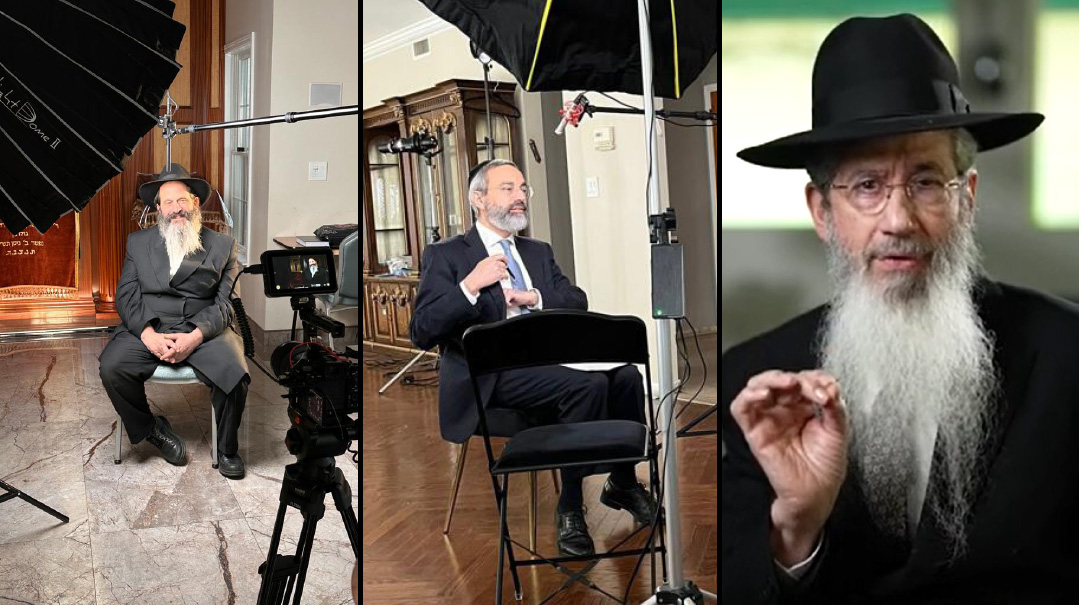
Rabbi Sholom Mordechai Rubashkin explained how he made sure to guard his eyes even in a place called prison (left); Rabbi Naftali Horowitz learned that his challenges meant he was normal; Rabbi Dovid Goldwasser offers a kabbalistic segulah for overcoming any temptation that comes your way
A recurring theme is the idea that the moment one overcomes temptation and looks the other way is a moment of awesome auspiciousness. The sefer Shomrei Emunim explains that in those precious seconds, one may daven for whatever they wish, and the power which that tefillah carries is unparalleled.
Additionally, financial success seems to be inherently linked with shemiras einayim. Several contributors have demonstrated this theme by quoting various sources, the most obvious being the story of Yosef himself. Yosef, who is the very paradigm of a shomer einayim, also happens to be the single most financially successful person in all of history. In the course of a few years, he requisitioned all existing wealth to fill the coffers of the kingdom which he ruled as second-in-command. All of humanity had to converge upon Yosef to receive basic sustenance. Such is the power of shemiras einayim; it has the power to open the floodgates of parnassah.
Rabbi Shlomo Landau, a regular Vayimaen contributor, recently received a phone call from a successful businessman who asked the rabbi if they could meet. Rabbi Landau agreed, and found himself sitting in an opulent office facing the uncomfortable-looking businessman.
“Listen,” the man said, “there was a business deal that I’d gotten involved in that was causing me enormous financial loss. This has been going on for a few years but there was no way for me to get out of it. Now I’ve joined the Vayimaen group and watch the daily videos. One day, my wife saw me watching and she said, ‘What are you doing about it?’ I looked up, unsure of what she meant. She explained, ‘You travel for business. You go on planes and stay in hotels. I know what you watch on those trips. Why don’t you take some of that Vayimaen advice and stop? We need the siyata d’Shmaya.’
“Rabbi,” the man continued, “I listened to my wife. On my next trip, I took along a stack of books to keep my mind occupied. I started this a few weeks ago. Then, out of nowhere, I got a call from someone who wants to buy out my share in the failing business. The money he offered me wouldn’t just cut my losses — it would gain me profit!”
But, Rabbi Landau qualifies, no one should think it’s some magic trick, and in fact it’s not these “miracle” stories that spur the enthusiasm.
“Someone approached me and voiced a complaint,” he says. “He told me, ‘Rabbi, I’ve been watching these videos and my life is still lousy. Parnassah isn’t great and shalom bayis could be better. What am I doing wrong?’”
Rabbi Landau took these words to heart. “The next video I did, I left out all the inspiring stories. I just spoke about the raw struggles we all have on the most basic level. And the feedback I got from that video was amazing. A rav called me up and said, ‘That was me! You were describing me!’ This is because we’re opening up the conversation that is so desperately needed to be had. Everyone contends with this issue, it surrounds us wherever we go, and yet, there’s little in terms of a platform from which it can be addressed.”
Rabbi Daniel Glatstein, another Vayimaen contributor, says the greatest miracle of Vayimaen is that it actually affects change. “True change of habit is a lifetime’s work, and even then, its chances of success are slim,” he notes. “But thousands of people have made significant changes in their lifestyle because of these videos. And that, in itself, is a miracle.”
In addition, he says, because Vayimaen is a movement that spans the globe, “when someone is confronted with a nisayon, he no longer feels alone. He feels part of the movement and his decision at that moment will either support, or disappoint, a unit of thousands of people.”
T
he clips have now been translated with subtitles into French, under the auspices of Simon Sebbagh. The French translation has over 1,000 subscribers.
It started when a friend of his, a father of eight children, had lost his eyesight in his left eye and somewhat in his right eye as well. “He then took it upon himself to begin working on shemiras einayim, signing up to Vayimaen. He sent me one of the videos,” Simon says.
But then a few weeks later, another friend of Simon’s lost his eyesight. “I was shocked, this was the second time that someone within my group of friends would contract such an unusual condition,” Simon relates. He felt he needed to do something and so he contacted Vayimaen. “I explained that I spoke both French and English and that, if I could write up French subtitles to the videos, Vayimaen would become accessible to thousands of French-speaking Jews.”
This arrangement was set up in short order, and three weeks later, Vayimaen had reached French-speaking communities in France, Switzerland, and Belgium. Simon is now working on setting up a list of French-speaking contributors so that, rather than read subtitles, his audience can watch the videos and hear the messages in their native tongue.
And some 5,000 miles away in Venezuela, Vayimaen videos are being translated into Spanish as well. “I had signed up for Vayimaen,” says Isaac Hussny, “and I realized how beneficial it would be if the Spanish-speaking community would be able to access them as well. I reached out to Vayimaen and presented them with the idea. They agreed, and I hired a fellow named Danny Harp to write the Spanish subtitles. There are now about 1,500 Spanish speaking subscribers.”
“I’ve gotten texts from Uganda,” says Pinchas Pernikoff, “and from Ukraine and from Russia. So many people from around the world want the videos translated into their language.”
T
here are many vessels for blessing, parnassah being just one of them. Yisroel Hershkowitz is one young man who’s seen the blessings flow in another area. This proud chassan would, if he could, give brachah achrita to Vayimaen at his upcoming chasunah.
Yisroel serves as the dorm counselor in Yeshiva Tiferes Bochurim in Monsey, New York. When one bochur confided in Yisroel that he needed chizuk in the area of shemiras einayim, Yisroel weighed the options on how best to help this talmid. Yisrael had heard people talking about the new daily video clips of chizuk on the topic of shemiras einayim, and there was something about their tone that struck him. He finally realized what it was: They were proud to be part of a movement taking on an issue that is usually associated with shame.
He introduced the boys to Vayimaen, and was thrilled by the enthusiastic reception it received. Someone suggested that, in addition to the videos, he should encourage the boys to read Positive Vision, a book about shemiras einayim published by ArtScroll in 2015. The book is divided into daily portions and Yisroel implemented a program where the boys study each day’s piece, chavrusa-style.
They did this for 11 consecutive days and set out to begin their 12th day, but the topic of the day was quite esoteric and the boys had a hard time understanding the concept. The day’s portion described an idea called “klipas nogah,” which, in simple terms, refers to things in the world that are neutral, neither holy nor unholy. Anything that is of such twilight nature, they learned, can be pulled in either direction, depending on the intent of the action. The boys wondered — is there no middle ground? Can’t someone enjoy a leisure activity without being subject to either extreme?
Yisroel thought about it and decided that rather than answering the question himself, he would reach out to the book’s author, Rabbi Avrohom Neuberger.
“Rabbi Neuberger, who lives in Monsey, offered to come down to the yeshivah to explain the concept, and we happily accepted,” Yisroel says. “Food was ordered for this informal session and the boys all sat around the table as Rabbi Neuberger described the nuanced idea in great detail. The shiur concluded and the boys filed out, satisfied with their newly gained understanding.
Then Rabbi Neuberger and Yisroel got to talking, and Yisroel mentioned how he was “in the parshah,” still looking for a shidduch. Rabbi Neuberger nodded, an idea percolating in his mind. On a whim, he suggested the shidduch that he had just thought of and went on his way.
Yisroel called him back a few days later. He had looked into the girl and was interested in pursuing the suggestion. A date was set up. Then another. Then another. Two weeks later, they announced their engagement.
In Tehillim 121, we reference an eternal expression of desperation, “Esa einai el heharim — I raise my eyes toward the mountains, mei’ayin yavo ezri — from where will my salvation come?”
Which mountains are these?
The gemara in Succah tells us that, when Mashiach comes, the yetzer hara will appear as a “mountain to the tzaddikim and as a fly to the resha’im.”
Those who spend a lifetime overcoming temptation, will merit to recognize the scope of their mountainous achievements.
With eyes lifted above all that surrounds them, the kovesh es yitzro stands as tall and strong as mountains.
From where our salvation will come.
(Originally featured in Mishpacha, Issue 971)
Oops! We could not locate your form.


